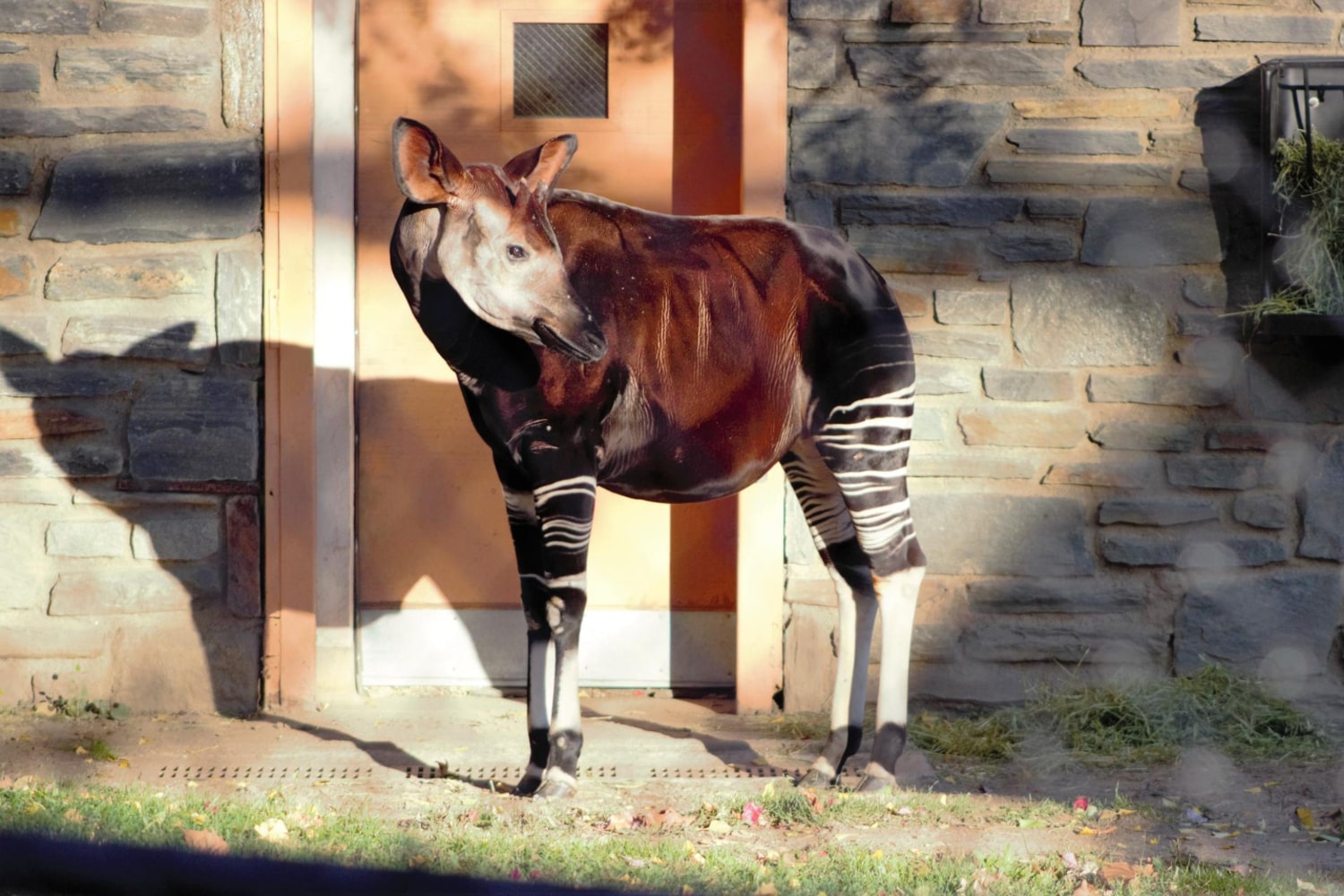The okapi is a rare and mysterious animal, often referred to as the “forest relative of the giraffe.” The scientific world learned about it only in the early 20th century, although the local people of the tropical forests of the Congo had known about it for centuries. Its unique appearance combines the traits of several animals, which led to long-standing debates about which species it belongs to. Today, the okapi is a symbol of the wildlife of Central Africa and one of the least studied mammals in the world. Below are fascinating facts about this remarkable inhabitant of the tropical jungle.
- The okapi is a close relative of the giraffe, although this may not be obvious at first glance. They share a similar body structure, a long neck, and a unique way of feeding. The okapi’s long bluish-purple tongue can reach up to 35 centimeters, allowing it to easily grasp leaves from high branches.
- The okapi’s coloration is very distinctive – a dark brown body with striking white stripes on the legs and hindquarters. This combination of colors helps the animal camouflage in the shadows of the tropical forest. The stripes also act as guides for calves so they can follow their mother.
- An adult okapi stands about 1.5 to 1.7 meters at the shoulder and weighs between 200 and 350 kilograms. Males are usually larger than females and have small horns covered with skin. Females lack horns, although they may have small bony protrusions.
- The okapi lives only in the dense tropical forests of the Democratic Republic of the Congo. They avoid open spaces and prefer areas far from human activity. This makes studying them in their natural habitat very challenging.
- These animals are solitary and have individual territories. Males mark their boundaries with urine and secretions from their scent glands, while female territories may partially overlap. Adults usually meet only during the breeding season.
- The okapi feeds mainly on leaves, young shoots, fruits, and sometimes mushrooms. It can consume up to 20 kilograms of vegetation per day. Its long tongue is used not only to grasp leaves but also to groom its own body.
- A young okapi is born after a gestation period of about 14 to 16 months. A newborn weighs around 14 to 30 kilograms and can stand on its feet within half an hour after birth. In the first weeks of life, it spends much of its time hidden to avoid predators.
- Unlike many hoofed animals, okapi calves do not defecate for the first few weeks of life. This reduces the risk of predators detecting them by scent. Such behavior is rare among mammals and is considered an evolutionary adaptation.
- In the wild, the main predator of the okapi is the leopard. Crocodiles can also pose a threat when the animal approaches water sources. However, the greatest threat to the species comes from humans through deforestation and poaching.
- The okapi has excellent hearing and sharp vision, which help it detect danger in time. They communicate using quiet low-frequency sounds that most predators cannot hear. They also convey information through scent signals.
- In the wild, the okapi’s lifespan is about 20 to 25 years, while in captivity it can live up to 30 years. In zoos, they are kept in large enclosures with dense vegetation to mimic natural conditions as closely as possible.
- The first scientific description of the okapi appeared in 1901, thanks to British explorer Harry Johnston. Before that, Europeans considered stories about the “forest zebra” to be mere legends. The discovery of the okapi became one of the most notable zoological events of the early 20th century.
- The okapi is considered a national symbol of the Democratic Republic of the Congo and appears on its coat of arms. Its image can also be found on local banknotes and postage stamps. This highlights the importance of protecting this unique species.
- Despite its protected status, the okapi’s numbers continue to decline. In recent decades, the population has decreased by more than 50 percent. This is due both to poaching and to the loss of its natural habitat.
- The International Union for Conservation of Nature has listed the okapi as an endangered species in its Red List. The creation of national parks, such as the Okapi Wildlife Reserve, is a key step in conserving these animals.
The okapi is one of the most mysterious mammals on the planet, living deep within the African jungle. These interesting facts show how unique this animal is and how little we still know about it. Its preservation requires the combined efforts of scientists, conservationists, and local communities. Protecting the okapi means preserving a part of Africa’s rich and irreplaceable natural heritage.





